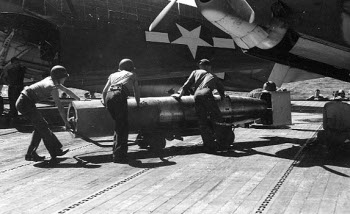![]() The Pacific War Online Encyclopedia
The Pacific War Online Encyclopedia
|
| Previous: U.S. Mark 10 Torpedo | Table of Contents | Next: U.S. Mark 14 Torpedo |

National
Archives #80-G-284708.
Cropped by author.
| Dimensions
|
22.4" by 13'5" 56.9cm by 4.089m |
| Weight |
2216 lbs 1005 kg |
| Range | 6300 yards (5760m) at 33.5 knots |
| Warhead | 600 lbs Torpex 262 kg Torpex |
| Propulsion | Alcohol-air two-stage impulse turbine |
| Production |
17,000 during the war |
The Mark 13 was the standard aircraft
torpedo throughout the war. It was developed in 1936 and entered
service two years later. Compared with the aircraft torpedoes of
other powers, such as the Japanese
Type 91, the
Mark 13 was short, fat, slow, and long-ranged. It was also
initially highly unreliable, requiring a drop at 50 feet (15m) at
110 knots and still often malfunctioning. It had poor depth
control and a tendency to deviate to the left. Its one bright spot
was that the contact detonator was reasonably reliable at the
relatively slow speed (33 knots) of the Mark 13.
According to Branfill-Cook (2014), Captain Frederick
Sherman of Lexington
observed that Japanese B5N Kates
launched their Type 91 torpedoes at high speed, and that the
torpedo on a Kate that had been shot down had a wooden box around its rudder.
This prompted the Navy to make the decision in late 1942 to begin
development of the Mark 25 to replace the Mark 13 while
simultaneously improving the aerodynamic characteristics of the
Mark 13 as an interim solution
Modifications to the air tails and the addition of plywood nose
drag rings allowed high speed drops from 1000 feet (300m) by
February 1944 and from 2400 feet (730m) and 410 knots by the end
of the war. Pilots were trained that the optimum drop was from
800' (240m) at 260 knots from a distance of 1400 yards (1300m).
This yielded a water entry angle of about 28 degrees after a fall
of 7 seconds over a horizontal distance of 1000 yards (900 m),
plus an additional water run of 400 yards (370m).
The nose drag ring or "pickle barrel" slowed the fall of the
torpedo by 40% and absorbed much of the shock of water entry,
while both the nose drag wing and the air tail prevented the
torpedo from oscillating as it fell, which could cause the torpedo
to hit the water at an unfavorable angle, damaging the torpedo or
causing it to roll and be thrown off course. The engine was
started using compressed air during the air drop, to avoid burning
out the turbines, and fuel was not fed to the combustion chamber
until impact with the water sheared a control wire. These
modifications reduced the range to 4000 yards, which mattered
little in typical tactical settings. The vast improvement in
reliability was fortunate for the Americans, since the Mark 25 was
not ready for production before the war ended.
The Mark 13 began to replace the Mark 8 on PT boats in early 1944. Since the Mark 13 could be launched by simply rolling it over the side of the boat, the boats were able to replace their heavy torpedo tubes with enhanced machine gun and cannon armament.

|

|

|

|
References
Roland
and Boyd (accessed 2017-1-2)
The Pacific War Online Encyclopedia © 2009-2010, 2014, 2017 by Kent G. Budge. Index